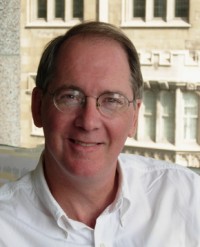Whodunit? A 9/11 conspiracy theory: A 9/11 conspiracy theory
According to theologian David Ray Griffin, the attacks of 9/11 were not the work of jihadist suicidal terrorists but were orchestrated by the Bush administration to provide the pretext for its military adventures and its quest for global dominance.
Griffin, an emeritus professor at Claremont School of Theology, well known in the academy for works on religious pluralism and process theology, has drunk deeply from the murky well of the “9/11 truth” forums on the Internet. Christian Faith and the Truth Behind 9/11 (Westminster John Knox) is his third book on the subject, but the first with the imprint of a mainstream—make that mainstream Presbyterian—publisher, which suggests that his loopy argument is making headway.
Perhaps that’s because Griffin delivers his conspiracy theory with the air of a professor patiently explaining a logical theorem (he is inordinately fond of the terms a priori and prima facie). He assembles a long list of items that apparently put into question the official explanation of 9/11 and concludes that the official explanation is “incredible.” This paves the way for his alternative thesis (for Griffin it is a “conclusive case”) based on the administration’s motives for lying.
Griffin’s opening observation illustrates the madness in his method. He notes that though the hijackers are alleged to have been devout Muslims, during their time in the U.S. they drank alcoholic beverages and visited strip clubs. The 9/11 commission never admitted or resolved this contradiction, Griffin says, apparently scoring his first point against the official explanation.
Griffin ignores the many reports showing that some hijackers (and other terrorists) exhibited exactly this psychological profile: they were alternately attracted and repelled by the moral laxity of the West; their sense of its allure spurred their sense of repulsion. Such modest nuances of reflection seem too much for Griffin. Furthermore, he doesn’t pursue what this alleged hole in the official explanation demonstrates. If the hijackers were undevout, that means they were tools of the U.S. government?
Conspiracy theories about 9/11 mostly involve intricate technical debates about such matters as the strength of the steel beams in the World Trade Center and the size of the hole in the Pentagon in relation to the size of a Boeing 757. New theories crop up as soon as others are refuted.
Griffin’s suspicions can be grouped into two main categories. The first is the fact and manner of the collapse of the twin towers. The crash of the airliners was not enough to undermine the structure of the buildings, he says, and even if it was, the buildings on their own would not have pancaked vertically they way they did. The collapse must have been caused by a “controlled demolition.”
His second major suspicion concerns the behavior of the Federal Aviation Authority and the Northeast Air Defense Sector. Their inability to intercept the hijacked planes is “implausible” in his view, and so he concludes that the White House wanted the attacks to proceed.
Griffin points to a series of delays that seem inexplicable to him. But audio tapes from NEADS, recently disclosed by Michael Bronner (in the online edition of Vanity Fair), reveal how confused the FAA and the military were on September 11. Once the hijackers turned off the planes’ transponders, neither the FAA nor the military had a good way of identifying the hijacked planes among others in the crowded northeast corridor. The air defense was so disoriented that it was still chasing phantom hijacked planes that afternoon. In those post–cold war days, the military had only four fighter jets to protect the northeast, and they were focused on external threats. The FAA’s normal means of handling hijackers was to notify the FBI and wait for the plane to land. No one had trained for dealing with hijacked planes being used as missiles. Given all this, the confusion and uncertainty at air defense were entirely plausible—vastly more so than Griffin’s thesis.
The question of the towers’ collapse involves a discussion of the heat at which steel loses its strength, the velocity at which a building collapses and the debris it generates. (Popular Mechanics refutes the major conspiracy theories about the WTC’s collapse in its March 2005 issue.) Griffin’s digest of various engineering theories may obscure for some readers the glaring problem with the theory of controlled demolition as well as with his overall argument: Is it really plausible that the government not only arranged for the hijackings but planted bombs in the WTC and set them off after the attack? This would mean that the Bush administration set up a vast conspiracy involving not only the hijackers and air defense but demolition experts and WTC officials, and is counting on all the participants keeping their mouths shut.
There is no positive evidence for any of this. Griffin never lays out fully his alternative scenario, much less subjects that to critical scrutiny—a sure sign that something has gone awry in practical reasoning. The book is controlled by the conviction—spelled out in the book’s second half—that neoconservatives are engaged in a “demonic” effort to build a global empire and will stop at nothing.
The war on terrorism has been invoked to sponsor a foolish military adventure. The disastrous overreach in Iraq was fueled by imperialist delusions about remaking the Middle East. But tying that critique of U.S. policy to an outlandish theory about U.S. complicity in 9/11 can only invite ridicule.
The question arises: Why did a Presbyterian publishing house sign up this corrosive and monomaniacal book? Taking a leaf from David Griffin, one might posit that it was an inside job. Shrewd Bush sympathizers within the publishing house were looking for a way to undermine Bush’s critics, so they seized upon this act of sabotage. A prima facie case can be made. . . .






